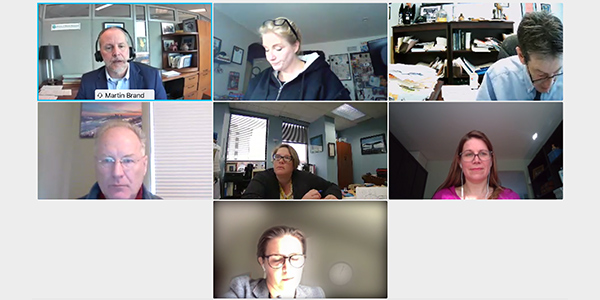Building end-markets for a circular economy is critical to reducing methane and carbon dioxide emissions from organic waste in the future, according to the New York State Climate Action Council (CAC) Waste Advisory Panel.
The organics diversion and landfills subpanel wants to see materials recovered for their next highest and best use to help meet New York’s climate goals, said Dereth Glance, executive director of the nonprofit Onondaga County Resource Recovery Agency.
“The secret to material management is movement, so we can’t have this stuff stockpiling,” Glance said during a Waste Advisory Panel meeting Wednesday. “We need to keep it moving all the time.”

The New York State Climate Action Council (CAC) Waste Advisory Panel met March 3. Clockwise from top left: New York DEC Deputy Commissioner Martin Brand; Bernadette Kelly, Teamsters Local 210; Michael Cahill, Germano & Cahill; Jane Gajwani, NYC DEP; Lauren Toretta, CH4 Biogas; Dan Egan, Feeding New York State; and Dereth Glance, OCRRA (center). | NYDPS
It is important to have procurement policies at the state and local level for municipalities purchasing recycled content material, buying compost for parks departments, road development, erosion control and other kinds of construction projects, she said.

Dereth Glance, OCRRA | NYDPS
“Not only are we going to be able to move food waste out of landfills and other disposal and into more productive use, but once we create that product, that compost, it has a reliable place to go to be used again,” Glance said.
Routing at least 90% of organics to composting should dramatically reduce organic waste, even in a city as large as New York, said Michelle “Tok” Oyewole, policy and communications organizer at the New York City Environmental Justice Alliance.
Brigitte Vicenty, founder of another recycling group, Inner City Green Team, said she supports imposition of a modest ($2) monthly recycling service fee, on a sliding scale, to be paid by both tenants and property owners to support door-to-door recycling. The fee, she said, would increase participation since people will feel that they already have “skin in the game.”

Brigitte Vicenty, Inner City Green Team | NYDPS
The Waste Advisory Panel is sharpening its recommendations to the full council ahead of a March 19 deadline.
“We are in the last push to get over the finish line and present final recommendations to the council toward the end of March,” said New York Department of Environmental Conservation (DEC) Deputy Commissioner Martin Brand, who chairs the waste advisory panel.
The waste panel received updates from its various subgroups on materials handling; wastewater treatment and recovery; organics diversion and landfills; local scale diversion; and climate justice.
Brand encouraged the subgroups to “keep honing the product down,” promising to get back to the panel members if the DEC arranges “some cross-panel deliberations, particularly on the renewable natural gas, biogas and bioeconomy piece,” because it is still a source of frustration and confusion.
Cash Incentives

The landfills subgroup recommended establishing an energy floor price not less than 10 cents/kWh for power purchase agreement payments for renewable natural gas and non-energy producing compost facilities to stimulate infrastructure upgrades and construction for management of organic wastes at landfills, combustors, digestors and compost facilities.
“We need a new generation of facilities,” said Michael Cahill, partner at the law firm Germano & Cahill. “We don’t have the digestors, we don’t have the compost facilities, we don’t have anything in that gap between generation and landfilling and combustion to fill the need, and we need to get a variety of people on the job to figure out how to make it work.”
The 10 cents/kWh charge would provide an incentive for planners to begin the process of experimentation, innovation and coordination to find a solution in the first five to seven years, according to Cahill.
Keep the Focus
The waste panel also plans to recommend to the full CAC building a distributed energy model that uses local waste and associated emissions/energy recovery to enable communities to be more climate resilient.

Resa Dimino, Resource Recycling Systems | NYDPS
Resa Dimino, senior consultant at Resource Recycling Systems, said it was not clear whether the distributed energy recommendation focuses on development of new waste disposal facilities, or maximizing the efficiency of existing facilities.
“If we want to get real climate benefits, we need to be investing in waste reduction, reuse, recycling and composting,” Dimino said. “Investing in landfills or waste-to-energy facilities that are slightly better than where we are now is not going to get us to the goals we need to reach.”
Eric Goldstein, New York City environment director at the Natural Resources Defense Council, agreed, saying “there is some ambiguity here when we’re talking about financial assistance and investments like encouraging private-public partnership investments through joint funding that values low-emission solid waste infrastructure investments.”

Eric Goldstein, Natural Resources Defense Council | NYDPS
One person’s definition of low-emission might not be another’s, so the focus of the waste advisory panel under the Climate Leadership and Community Protection Act ought to be on reducing emissions, he said.
The distributed energy idea is unique “in that it’s almost equally if not more an adaptation strategy as it is a mitigation strategy,” said Lauren Toretta, president of Greenwich, Conn.-based CH4 Biogas.
She said that extensive work by utilities and NYSERDA to support microgrid infrastructure will help communities benefit from waste-to-energy opportunities.
“We see it as an opportunity if you can leverage the waste resources and associated energy generation to help communities be more independent and more resilient,” Toretta said.



